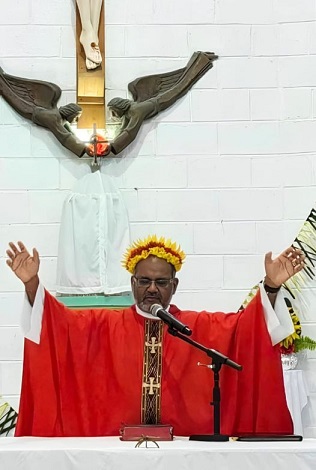Looking forward to Episcopal Ordination, Simon Mani, July 27th. MSC Kiribati
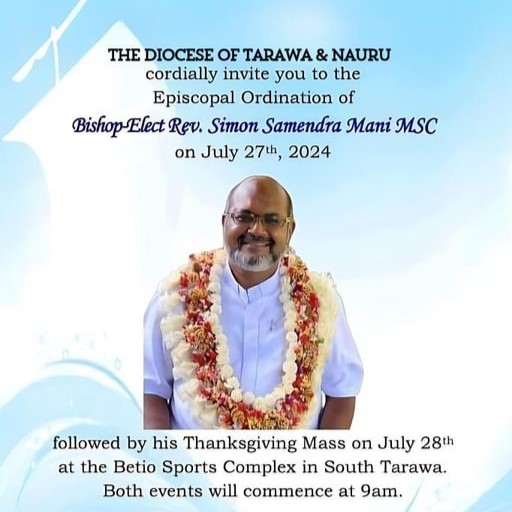
MSC missionaries arrived in Kiribati only a few years after the arrival of MSC in Sydney. There have been strong links between Kiribati and Australia.
ARRIVAL OF THE ROMAN CATHOLIC CHURCH
Among the people recruited in the 1870s as workers to Tahiti were Betero and Tiroi from the island of Nonouti. During their stay in Tahiti, they became members of the Roman Catholic Church. Their belief was so strong that when they returned to Nonouti in about 1880, they started to convert the people of their island. A number of people were converted and baptized by Betero and they decided to build churches in their villages; they built eight small churches altogether. When the churches were completed, Betero and Tiroi sent a request to Samoa for missionaries to be sent to Nonouti.
In response to the request, three missionaries from the Sacred Heart Mission, which had its headquarters in France were sent in 1887 and arrived at Nonouti in 1888. They were Father Joseph Leray, Father Edward Bontemps and Brother Conrad Weber. Father Leray was later appointed as the first Bishop in the Gilberts.
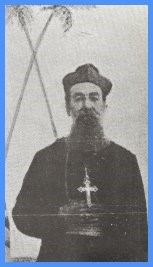
Bishop Joseph Leray
After the first Catholic Mission had been established on Nonouti the priests visited other islands trying to spread their faith. Other priests and later some nuns arrived to help them. Because of the strength of the London Missionary Society in the Southern Gilberts, the Catholic Church could not make much progress there, but in the Northern and Central Gilberts, where the American Mission were reducing its efforts, the Catholic Church won many followers.
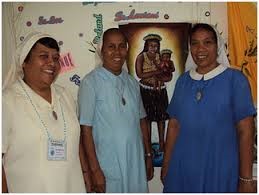
OLSH Sisters, Kiribati
In 1898, Father Leray removed a young teacher from his pupils at the Little Order of Issouidon and brought him back to the Gilberts. This was Father Alexandre Cochet, a young man with firm ideas and clear-cut plans. Father Cochet was first landed in the Ellice Islands (Tuvalu) with a colleague. They were there for fifteen months living in a rough shelter, and they succeeded in carrying one baptism in secret. Then they were recalled to Tarawa. Father Cochet had his plans of which he reminded the Bishop "Monsignor, I came to the Gilberts to write books. Please consider this, for I have no other reason for existing or being here".
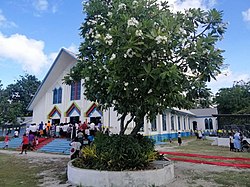
For these future books, he already had a printing press, but he needed printers. Father Cochet and Brother Etienne gathered several students together and went off to Abaiang. In a virtual desert on the southern part of the island, at Teaoraereke, they found the site. When they had cleared the land and installed several wooden boxes, Father Cochet, sitting between two open doors could see both ocean and lagoon and spit in each one on either side so he said.
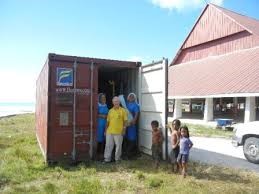
Long-serving Australian MSC on Kiribati, Albert Yelds
At Teaoraereke, Father Cochet composed and translated books. He wrote 2500 pages in less than 15 years - nearly 30 books and brochures whose printing he supervised as well as his printing press and the school he had charge of a parish comprising about a third of Abaiang. The school was supported by the sale of books and a small grant. It was also necessary for the pupil to find some of their food. There were really more than twenty of them.
Abaiang has the distinction of being one of the cradles of Christianity and schools both Protestants and Catholics in the Gilberts Group. It is also the place where the Bible was translated into Gilbertese in addition to the vast amount of publishing and translating undertaken by Father Cochet. The Catholic school of Tabwiroa was also founded and had its origin in the Roman Catholic Church on Abaiang.
